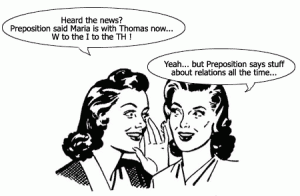
✅ AI Essay Writer ✅ AI Detector ✅ Plagchecker ✅ Paraphraser
✅ Summarizer ✅ Citation Generator
What is a Preposition?
We can think of prepositions (on, at, in…) as small verbs that help describe something. But without a word following it (determiner), a preposition does not mean too much. A preposition is a part of a team that makes a phrase work well.
Example:
There was an old, skinny cat on a comfy bed. Outside, the wind was blowing through fall leaves. The cat was not scared of the wind rustling beyond the comfort of the bed—near her was her best friend, Kathy.
Using Prepositions
English prepositions can be confusing sometimes: we sleep on a couch, but sleep in a bed—we watch movies at a theater, yet we watch shows on a television. The following information will clarify how to use prepositions.
*Time Prepositions: in, on, and at
– Use in to describe non-specific times within a day, month, year, or season.
Examples:
Anna loves jogging in the evening.
She drinks coffee only in the first half of the month.
Once in a year, Clarence drinks water.
I heard Dan is going to Italy in the winter.
– Use on to talk about days and dates.
Examples:
My sister is coming back from India on Tuesday.
You’re invited to a party on Halloween.
– Use at for showing a specific time.
Example:
Our bus is coming at 12:30 p.m.
*Place Prepositions: in, on, and at
– Use in for names of areas of land (towns, countries, continents, and states).
Examples:
I used to live in the town of Hollern.
My brother resides in Ukraine at the moment.
In North America, there are more donkeys than pigs.
It was in the state of New York that my grandfather first saw skyscrapers.
– Use on to talk about specific streets, avenues, and the like.
Example:
His apartment was on Liams Avenue.
– Use at for a specific address.
Example:
You need to come to the job interview at 2223 Pillard Place.
*Movement Prepositions: to, towards, and no preposition
– Use to if you want to show movement to a place.
Example:
Brian went to the hardware store.
– Use towards to show general movement.
Example:
When my grandfather read books, he always leaned towards a green lamp light.
– Don’t use prepositions before the words home, downtown, uptown, inside, outside, downstairs, upstairs.
Examples:
Bobby ran upstairs like a madman.
While driving downtown, Anna started to cry because of her recent breakup with her boyfriend.
I dove inside the murky water of Lake Washington to pull out my drowning cat.
Most Commonly Used Prepositions
- of 11. as 21. before
- in 12. into 22. under
- to 13. like 23. among
- for 14. through 24. around
- with 15. after 25. during
- on 16. over
- at 17. between
- from 18. out
- by 19. against
- about 20. without
Follow us on Reddit for more insights and updates.



Comments (0)
Welcome to A*Help comments!
We’re all about debate and discussion at A*Help.
We value the diverse opinions of users, so you may find points of view that you don’t agree with. And that’s cool. However, there are certain things we’re not OK with: attempts to manipulate our data in any way, for example, or the posting of discriminative, offensive, hateful, or disparaging material.
Comments are closed.